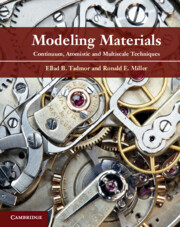Book contents
- Frontmatter
- Contents
- Preface
- Acknowledgments
- Notation
- 1 Introduction
- Part I Continuum mechanics and thermodynamics
- Part II Atomistics
- Part III Atomistic foundations of continuum concepts
- Part IV Multiscale methods
- 10 What is multiscale modeling?
- 11 Atomistic constitutive relations for multilattice crystals
- 12 Atomistic–continuum coupling: static methods
- 13 Atomistic–continuum coupling: finite temperature and dynamics
- Appendix A Mathematical representation of interatomic potentials
- References
- Index
13 - Atomistic–continuum coupling: finite temperature and dynamics
from Part IV - Multiscale methods
Published online by Cambridge University Press: 05 June 2012
- Frontmatter
- Contents
- Preface
- Acknowledgments
- Notation
- 1 Introduction
- Part I Continuum mechanics and thermodynamics
- Part II Atomistics
- Part III Atomistic foundations of continuum concepts
- Part IV Multiscale methods
- 10 What is multiscale modeling?
- 11 Atomistic constitutive relations for multilattice crystals
- 12 Atomistic–continuum coupling: static methods
- 13 Atomistic–continuum coupling: finite temperature and dynamics
- Appendix A Mathematical representation of interatomic potentials
- References
- Index
Summary
In Chapter 12, we discussed a suite of static atomistic–continuum coupling methods, all with the goal of being an approximate, more efficient alternative to molecular statics (MS) (Chapter 6). While there are many such methods, we demonstrated that they can all be described within a common framework, and summarized the various options that one can select within that framework to define a specific variant of the coupling procedure. We deliberately avoided the question of dynamic multiscale methods in that discussion.
Here, we look at methods whose goal is to be an approximate, low-cost alternative to molecular dynamics (MD) (Chapter 9). The general idea is still embodied in Fig. 12.2, as we envision partitioning the body into two regions: one (BA) that will be treated atomistically using full MD and another (BC) that can be approximated using a continuum approach (commonly discretized using finite elements). Instead of seeking an equilibrium configuration for the body, we now have time-dependent boundary conditions (including prescribed displacements, atomic forces and continuous tractions) and a set of initial conditions from which we want to follow the evolution of the system. In the atomistic region, this means the trajectories of all the atoms. In the continuum region, this may include a discretized approximation to the mean displacement, velocity and temperature fields.
Superficially, this sounds like a straightforward extension of static methods, but in fact there are additional difficulties that make the problem much more complex.
Information
- Type
- Chapter
- Information
- Modeling MaterialsContinuum, Atomistic and Multiscale Techniques, pp. 658 - 689Publisher: Cambridge University PressPrint publication year: 2011
